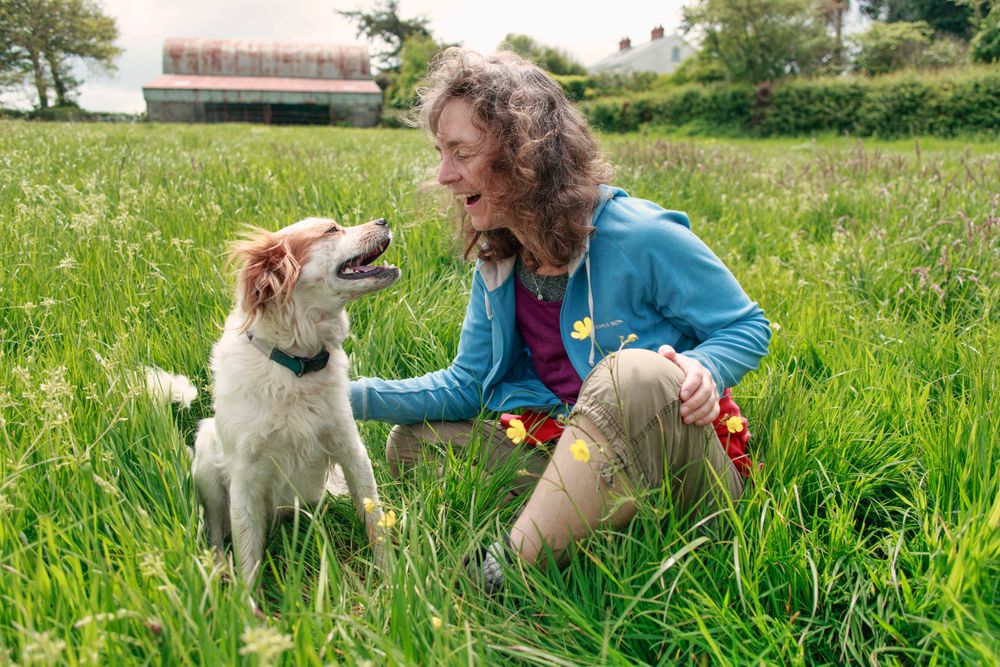Barking is one of the most common forms of vocal communication among dogs. While it can be a natural and necessary means of expressing emotions, such as alerting their owners of potential danger or calling attention to their needs, excessive or inappropriate barking can become a nuisance or a source of stress for both dogs and humans. In this post, we will explore:
- Why dogs bark
- Different types of barking and their motivations
- How to reduce your dog’s barking
Let’s get started!
Why dogs bark
Barking is a natural behavior for dogs, and they use it as a form of communication. Dogs can bark for various reasons, such as to alert their owners to danger, express their excitement, or communicate their needs. To address excessive barking, it's crucial to understand the motivation behind it. Dogs bark to achieve a specific goal or to gain something, whether it's attention, food, or playtime.
Different types of barking, treatment, what not to do and other considerations
1. Attention seeking barking
“Play with me!” … “Look at me!”
How to identify attention seeking barking:
- May be preceded by sneezing, yawning, or whining
- Sharp and persistent sounding
- Usually medium to high pitch, although this can vary between dogs
- Confident body language, with your dog standing up and forward
- May stop when you make eye contact or give attention to your dog
- Your dog is typically oriented towards the owner or the thing they want. For example, if a ball is under the couch, your dog may bark while facing towards the couch.
Treatment for attention seeking barking:
- Meet your dog's exercise and enrichment needs by providing opportunities for play, mental stimulation, and physical activity. This can include things like meals from food toys or DIY toys, sniffing games, going for light jogs (if your dog is over 1 year), or playing indoor fetch and tug.
- Teach your dog alternative behaviors to barking, such as sitting quietly or staring at you. Reinforce these behaviors through positive reinforcement training.
- Ignore demand barking or use negative punishment by removing your attention when your dog barks. Timing is critical in ensuring that your dog learns that barking does not result in attention or rewards.
- Teach your dog helpful skills like "Sit" as a default behavior when they want something, "Relaxation Protocol" for calmness, "Go to Place/Mat" for calming down, and "Wait" for impulse control. These skills can help your dog learn to manage their behavior and cope with stress or frustration.
What not to do:
- Avoid looking at, talking to, touching, or yelling at your dog in response to their barking. Doing so may reinforce the behavior by giving your dog attention or rewards.
Other considerations
- Start with prevention early by teaching your dog alternative behaviors and providing them with plenty of exercise, mental stimulation, and socialization. While ignoring the behavior is often the most effective approach, it can be challenging to do so in an apartment setting where barking may disturb neighbors. In such cases, you may want to consider using earplugs or informing your neighbors about the situation.
- Be aware of the extinction burst, which is a temporary increase in the intensity or frequency of the barking behavior when it is no longer reinforced. This is a natural part of the learning process, and it's essential to remain consistent in your response to the behavior to ensure it is fully extinguished over time.
2. Frustration or boredom barking
“Let me get to that bird!” … “Gimme my dinner now!”
How to identify frustration barking:
- Typically repetitive and monotone, with a medium to high pitch that may vary between dogs.
- It may be accompanied by pawing, whining, or other frustration behaviors.
- Frustration barking can be a sign that your dog is bored or lacks stimulation, so it's essential to provide them with plenty of opportunities for exercise, mental enrichment, and socialization.
- Your dog may display confident body language, standing up and forward while barking.
- They are likely oriented towards a particular stimuli, such as a person, object, or another animal.
Treatment for frustration or boredom barking:
- Make sure your dog's exercise and enrichment needs are met.
- Use slow and systematic desensitization to address your dog's frustration triggers.
- Start with a low-intensity exposure and gradually increase it.
- Teach your dog an incompatible behavior, such as a "touch" cue before greeting another dog on a leash.
- Control the consequences of barking by not letting your dog access the thing they want when they bark.
- Teach your dog useful skills like sitting, targeting, waiting, and relaxation techniques.
What not to do:
- Avoid yelling at your dog or repeatedly jerking the leash (it won't help; they’re not “hearing” you).
- Don't let your dog get what they want (such as interacting with another dog or getting a treat) by barking or engaging in other unwanted behaviors.
Other considerations
- Sometimes this type of barking can be confused with "distance-increase" or "attention-seeking" barking.
- If the barking is due to "distance-increase," it may require a more nuanced approach to address the underlying emotional state.

3. Alert/watchdog barking
“Do you hear that!?” … “Look at the mailman at our door!”
How to identify alert/watchdog barking:
- Usually medium to lower-pitched (may vary depending on your dog)
- Confident body language (up/forward)
- Likely oriented towards a stimulus For instance, if your dog hears a sound in the hallway, they may run to the door.
Treatment for alert/watchdog barking:
- Environmental management. For example, use a white noise machine or a fan to block out external sounds and/or prevent access to areas that trigger barking.
- Teach the "3 bark rule.” To do this, say "thank you" to acknowledge the barking and cue your dog to perform a different behavior once they’ve barked three times.
- Establish a consistent routine
- Teach your dog a few helpful skills including: desensitization and counterconditioning to sounds (e.g., doorbell), relaxation protocol, “go to mat”, targeting
What not to do:
- Do not yell at your dog. They may think you’re “chiming in”
Other considerations
- Differentiate this behavior from “distance-increase” or “attention-seeking” barking
- Keep in mind that this behavior is natural for dogs that were selectively bred to alert humans
- Address the behavior if it becomes excessive
- Consistency is key, respond to the behavior every time it occurs.
4. Distance increase/suspicion barking
“Get back!” … “I need space!” … “What’s that!?”
How to identify distance increase/suspicion barking:
- Both types usually have a low pitch
- May be preceded by growling
- Uncertain body language, with your dog's back down
- Your dog may move towards and away from perceived threat while vocalizing.
Treatment for distance increase / suspicion barking:
- Identify the triggers, make a list of the triggers and the distance at which barking occurs
- Manage your dog’s environment and avoid encountering the triggers unless you’re prepared to train
- Slow, systematic desensitization and conditioning to triggers
- Useful skills to teach your dog include: “Find it”, “Look”, Relaxation Protocol and loose leash walking (as this behavior often occurs on leash)
What not to do:
- Avoid allowing your dog to stay over-threshold and continue barking.
- Refrain from yelling or physically punishing your dog, as it may only provide temporary relief and fail to address the underlying cause.
Other considerations
- Learn about thresholds and body language
- Be consistent, patient and systematic
5. Distress or anxious barking
“Come back!" ... "Why did you leave me!"
How to identify distress or anxious barking:
- Usually high-pitched and repetitive
- Pitch tends to increase as your dog becomes more agitated
- Often accompanied by other signs of anxiety, such as pacing, panting, drooling, or scratching
- Indicates a state of panic in your dog and requires intervention to help your dog calm down.
Treatment for stress or anxious barking:
- Identify and make a list of the triggers that cause distress barking
- Manage the environment by avoiding triggers that cause distress barking
- Use desensitization and counterconditioning techniques to gradually expose your dog to triggers and reduce their stress response. Start at a low threshold, leave your dog alone with the trigger for only a short time, and slowly increase the duration as your dog becomes comfortable.
- Teach helpful skills such as the Relaxation Protocol.
What not to do:
- Avoid flooding (i.e., leaving your dog alone to "work out" their emotions).
- Avoid yelling or physically punishing your dog as it may temporarily decrease the behavior, but it doesn't address the root cause of the behavior.
Other considerations
- Learn about thresholds and body language
- Be consistent, patient and systematic, desensitization takes time
Frequently asked questions about barking
How can I get my dog to stop barking at things?
To get your dog to stop barking at things, use positive reinforcement to change their underlying feelings about the things they’re barking at. Do this by providing them with a special treat or toy, every time you expect a triggering event to happen. For example, if the food delivery person is about to ring the doorbell, and your dog barks at the doorbell, provide them with a work to eat toy (like the Toppl) right before the delivery person arrives.
Can you really train a dog not to bark?
You can help your dog to feel better about the things triggering them to bark, and doing so will result in your dog barking less. To help your dog feel better about the things triggering them to bark, pair the trigger with something your dog loves. For example, if your dog barks at people on skateboards, give your dog a treat every time they see a person on a skateboard. Over time, this practice will help your dog develop a positive association towards skateboards and they will bark less.
Why does my dog bark so much?
Your dog is barking because they are:
- Seeking attention. Typically higher-pitched, and your dog will be looking at you.
- Anxious. Typically higher-pitched and continuous.
- In “watchdog” mode. Typically lower-pitched and results in your dog going to the door or in the direction of the “thing” they’re barking at.
- Uncomfortable and need distance from a person, place or thing. Typically lower pitched and intended to help your dog create space from a person, place or thing and may be accompanied by moving back and forth towards the perceived threat.
- Frustrated or bored. Typically higher-pitched and the result of your dog not getting enough exercise or mental stimulation.
Determining why your dog is barking is the first step to managing their barking behavior.
Is it bad to use a bark collar to stop my dog from barking?
At Petcademy we believe in, and teach, positive reinforcement based methods, and are consequently opposed to fear/pain based tactics such as shock collars, prong collar, bark collars or any other techniques rooted in punishment. Our approach is inline with organizations such as Best Friends Animal Society, the ASPCA and the Humane Society of the United States. Read more about our training methods and beliefs here.




